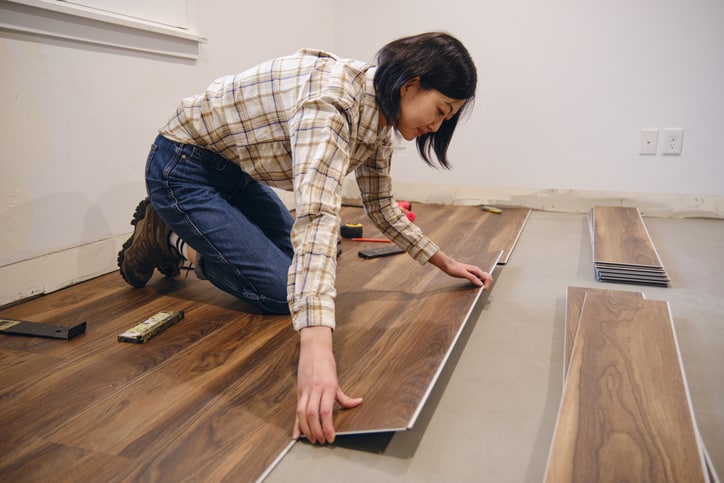Flooring is one of the most important aspects of home design. It not only impacts the aesthetic appeal of a room but also plays a key role in its functionality. Whether you’re renovating an existing space or designing a new one, selecting the right flooring is essential for achieving the desired look and performance. From comfort to durability and style, the right flooring choice can elevate your home’s atmosphere.

The Importance of Flooring in Interior Design
Flooring sets the tone for the entire room and can affect how the space feels. It serves as the foundation for your furniture and decor, and it helps to define the room's style, whether it’s modern, rustic, traditional, or contemporary. When chosen thoughtfully, flooring can enhance the room’s color scheme, create flow between spaces, and even make small rooms appear larger.
In addition to aesthetics, flooring has practical purposes. It protects the foundation of your home, reduces noise, and offers insulation. Selecting flooring that complements the needs of each room, such as moisture resistance for bathrooms or durability for high-traffic areas, ensures long-lasting beauty and functionality.
Types of Flooring to Consider
There are various types of flooring, each offering unique benefits and aesthetics. Some popular choices include hardwood, laminate, tile, vinyl, and carpet. Understanding the differences between these options is essential for selecting the right one for your home.
Hardwood Flooring Hardwood flooring is a timeless and classic option that adds warmth and elegance to any room. Available in a variety of wood species like oak, maple, and cherry, hardwood floors are durable and can last for decades with proper care. They are ideal for living rooms, dining areas, and bedrooms. With proper maintenance, hardwood floors retain their beauty over time and increase the overall value of your home.
Laminate Flooring Laminate flooring is an affordable alternative to hardwood that mimics the look of natural wood or stone. It is made from composite materials with a printed surface layer that replicates the appearance of wood grain or tiles. Laminate is easy to install and maintain, making it a popular choice for families with children or pets. It is also resistant to scratches and fading, making it a great option for high-traffic areas.
Tile Flooring Tile flooring, available in ceramic, porcelain, and natural stone, is an incredibly versatile and durable option for any room. Ceramic and porcelain tiles are ideal for areas that are exposed to moisture, such as bathrooms and kitchens. They come in a wide range of colors, patterns, and textures, offering endless design possibilities. Natural stone tiles, like granite, marble, and slate, offer a luxurious feel and are perfect for areas that require an upscale look.
Vinyl Flooring Vinyl flooring is another budget-friendly option that offers exceptional durability and comfort. Available in sheets, planks, or tiles, vinyl can mimic the look of wood, stone, or tile, providing versatility in design. It is water-resistant and can handle moisture, making it suitable for bathrooms, kitchens, and basements. Vinyl is also soft underfoot, which makes it comfortable to walk on for long periods of time.
Carpet Flooring Carpet provides comfort and warmth, making it a popular choice for bedrooms, living rooms, and home offices. It comes in a variety of textures, colors, and patterns, giving homeowners many options to customize their spaces. Carpet is also an excellent choice for insulation, helping to keep rooms warm in colder climates. However, it does require regular maintenance, such as vacuuming and occasional deep cleaning, to keep it looking its best.
Factors to Consider When Choosing Flooring
When selecting flooring for your home, there are several factors to keep in mind to ensure you make the best decision. Here are some key considerations:
Room Functionality: Consider the function of the room when choosing flooring. For high-traffic areas like hallways, kitchens, and living rooms, opt for durable and easy-to-maintain options like laminate, tile, or vinyl. For bedrooms or home offices, carpet or hardwood might be more comfortable and suitable.
Style and Design: The style of the flooring should align with the overall design theme of your home. For a contemporary or modern look, hardwood or tile might be a good choice. For a more traditional or rustic aesthetic, natural stone or carpet could be more fitting.
Budget: Flooring can vary greatly in price, depending on the material and style. While hardwood and natural stone can be more expensive, laminate and vinyl are more affordable. Set a realistic budget based on your preferences and the size of the space you’re renovating.
Durability: Think about how much wear and tear your flooring will experience. For areas prone to heavy traffic or moisture, like kitchens or bathrooms, durable and water-resistant options such as tile, vinyl, or laminate are ideal.
Maintenance: Different flooring materials require different levels of maintenance. Hardwood and tile are relatively low-maintenance but might require occasional refinishing or grout cleaning. Carpet and vinyl may need more frequent cleaning, especially in high-traffic areas.
Comfort and Noise Control: If you’re looking for a flooring option that offers comfort underfoot, carpet or vinyl might be your best bet. These materials also help reduce noise and create a cozier atmosphere in living rooms or bedrooms.
Conclusion
Choosing the right flooring for your home is an important decision that can influence the style, functionality, and comfort of your living space. By considering factors such as room use, design preferences, budget, and maintenance requirements, you can select the perfect flooring option that suits your needs and enhances the beauty of your home. Whether you opt for the timeless elegance of hardwood, the affordability of laminate, or the durability of tile, there’s a flooring option that’s perfect for every room in your home.